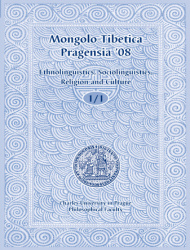MONGOLO-TIBETICA PRAGENSIA '08, Ethnolinguistics, Sociolinguistics, Religion and Culture. Vol. 1, No. 1. 2008

Editors-in-chief: J. Vacek and A. Oberfalzerová
Triton, Praha 2008, 145 pp.
ISSN 1803-5647
Editorial Board:
Daniel Berounský (Charles University in Prague)
Katia Buffetrille (École pratique des Hautes-Études, Paris)
J. Lubsangdorji (Charles University Prague)
Marie-Dominique Even (Centre National des Recherches Scientifiques, Paris, France)
Tsevel Shagdarsurung (National University of Mongolia, Ulaanbaatar, Mongolia)
Domiin Tömörtogoo (National University of Mongolia, Ulaanbaatar, Mongolia)
Reviewed by Prof. Bohumil Palek (Charles University in Prague)
and Prof. Tsevel Shagdarsurung (National University of Mongolia)
Institute of South and Central Asian Studies, Seminar of Mongolian Studies
Faculty of Arts, Charles University in Prague
Celetná 20, 116 42 Praha 1, Czech Republic
http://mongolistika.ff.cuni.cz/
Published by Triton
First edition, Praha (Prague) 2008
ISSN 1803-5647
Registration number of MK ČR E 18436
The publication of this journal was financially supported by the Ministry of Education of the Czech Republic as a part of the Research Project No. MSM0021620825 “Language as human activity, as its product and factor”, a project of the Faculty of Philosophy, Charles University in Prague.
For acquisition please contact
Contents:
Alena Oberfalzerová (Charles University in Prague):
Fear and contentment as experienced by the Mongolian nomads. Nutag.
This paper presents the results of our fieldwork in rural Mongolia, this time discussing the main psychological aspect of the life of Mongolian nomads - their relationship to their native land ( nutag). For the nomadic Mongol the nutag is the most important place in his whole life.
The paper refers to several areas, in which the relation between native land and the nomads has evidently been reflected. First it is folklore, which is the mirror of nomadic thought, then follows the usage of the word nutag in language- a discussion of typical idioms, phrases and metaphors. The third part of the paper is devoted to dreams about native land - nutag. It demonstrates the importance of this phenomenon in the life of the Mongolian nomads using samples of authentic discussions of dreams by my informants. The last section is intended to induce a realistic picture of the experience of a Mongol living in his native land. The fragmentary recollections of a concrete person put the finishing touches to the paper, by giving expression - not only to the difference of milieu, but also to the different manner of its perception, which determines the communicative behaviour of a nomad and in fact also the whole of his later life.
The topic of contentment and fear in the life of Mongolian nomads will later be discussed in connection with another psychological aspect of the relation to the Mother Nature - viz anxiety and fear of her in the context of her worship.
J. Lubsandorji (Charles University in Prague): Diacritic marks in the Mongolian script and the ´darkness of confusion of letters´
This paper deals with some of the results of the 18th century critical discussion and argument among scholars concerning the usage and function of the dots as diacritic marks in Mongolian script. This is of importance not only for research into the history of Mongolian philology but also for the present and future practical use of the Mongolian script. There are two dots in front of (i.e. to the left of) the Mongolian letter γ (designating voiced back velar in classical Mongolian orthography). However, there were many variants in the usage of the dots and in the 18th century this became the subject of argument and sharp criticism, which even referred to the situation as the ´darkness of confusion of letters´ ( üsüg-ün endegürel-ün qarangγui, Kh. үсгийн эндүүрлийн харанхуй).
Jaroslav Vacek (Charles University in Prague): Verba dicendi and related etyma in Dravidian and Altaic
4.1 Etyma with initial dentals ( t-,d-,n-)
The paper continues the systematic survey of verba dicendi as presented in the previous volumes of Mongolica Pragensia ( ´03,´04,´05,´06,´07). The subject is the etyma with the above defined structure, viz initial dentals ( t-,d-,n-) with all the various root final consonants except root-final liquids and retroflex stops. The general principles and theoretical considerations for this study were presented in some of my earlier papers ( e.g. Vacek 2004b or 2006a). The arrangement of the etyma follows the same formal criteria as in the previous papers. It includes verba dicendi in the narrow sense of the word and also semantic extensions and onomatopoetic expressions.
Review section:
Taube, Erika, Tuwinische Folkloretexte aus dem Altai (Cengel / Westmongolei). Kleine Formen. Serie Turcologica Bd. 71. Harrassowitz Verlag, Wiesbaden 2008 (reviewed by Klára Boumová)
D. Tumurtogoo (ed.), Mongolian Monuments in Uighur-Mongolian Script (XIII–XVI Centuries). Introduction, Transcription and Bibliography. With the collaboration of G. Cecegdari. Language and Linguistics Monograph Series A–11. Institute of Linguistics, Academia Sinica, Taipei 2006 (reviewed by Ondřej Srba)
Yo. Zhanzhiv, Songodog mongol ömnöh üeijn dursgluud (The Preclassical Mongolian Monuments). Corpus scriptorum, Tomus II. MUIS, Mongol hel soyoliin surguul, Türeg sudlaliin tenhim. Revised second edition, Ulaanbaatar 2006 (Annotated by Ondřej Srba)

